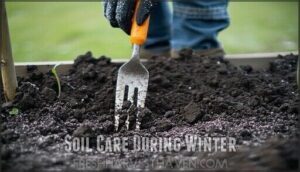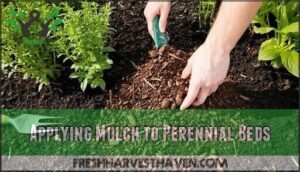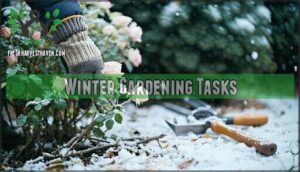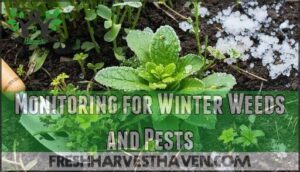This site is supported by our readers. We may earn a commission, at no cost to you, if you purchase through links.
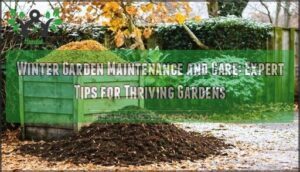
Start by cleaning tools and draining hoses to prevent freeze damage.
Protect tender plants with burlap or frost cloth, and apply thick mulch around perennials for root insulation.
Don’t forget to water during dry winter spells – plants still need moisture.
Remove dead debris to prevent disease, and bring potted plants indoors.
Add compost to beds and monitor for winter weeds.
Sharp, clean tools make spring prep easier.
Winter’s quiet pace offers perfect planning time for next season’s garden dreams and ambitious planting schemes.
Table Of Contents
- Key Takeaways
- Winter Garden Preparation
- Soil Care During Winter
- Plant Protection Strategies
- Winter Gardening Tasks
- Maintaining Garden Health
- Frequently Asked Questions (FAQs)
- What is end of winter garden maintenance?
- How to maintain a garden in winter?
- Is winter a good time for gardening?
- What can be done during plant dormancy in late winter gardens?
- How do I prepare my garden for winter?
- What are some garden tasks for end of winter on dry days?
- How to maintain a winter garden?
- Are you supposed to cut back plants for winter?
- What do you put on your garden in the winter?
- Should I leave dead plants in the garden over winter?
- Conclusion
Key Takeaways
- Clean and protect your tools before winter hits – drain all hoses, store equipment in dry locations, and apply oil to metal surfaces to prevent costly freeze damage and rust
- Shield plants from harsh conditions – wrap sensitive varieties in burlap, apply 2-4 inches of mulch around perennials, and bring potted plants indoors before the first frost
- Keep watering during dry winter spells – dormant plants still need moisture, especially evergreens, so check soil and water when temperatures are above 40°F
- Use winter’s downtime for garden prep – remove dead debris to prevent disease, add compost to beds, and plan your spring projects while plants rest
Winter Garden Preparation
Winter preparation guarantees your garden survives harsh weather and thrives when spring returns.
Start by cleaning tools, draining water systems, protecting plants from frost, and insulating outdoor faucets to prevent costly damage.
Cleaning and Storing Garden Tools
Before winter sets in, your garden tools need proper care to survive the cold months. Start by cleaning all tools with a stiff brush to remove soil and debris.
Proper tool care during winter’s downtime prevents spring frustration and extends equipment life significantly.
Use steel wool to scrub away rust spots, then apply a thin coat of mineral oil to prevent tool rust prevention. This simple step protects metal surfaces from moisture damage.
To further safeguard your tools, consider specialized products for rustproofing. Store cleaned tools in a dry location like your garage or shed.
Hang them on pegboards or place them in toolboxes to prevent contact with damp floors. Winter provides the perfect time for tool inventory management and sharpening techniques.
Inspect each tool for damage, noting which need blade sharpening or handle maintenance before spring. Safe storage practices and regular garden tools maintenance guarantee your equipment stays ready for next season’s gardening tasks.
Draining Hoses and Drip Lines
After the growing season ends, your watering systems need proper care to survive winter’s harsh conditions. Preventing freezing damage starts with thorough preparation of all irrigation components.
Here’s your essential checklist for winterizing systems:
- Disconnect all hoses from spigots and drain completely
- Store hoses coiled in a dry garage or shed for equipment longevity
- Use compressed air to blow out drip line maintenance water
- Remove and store sprinkler attachments in covered areas
Frozen water expands and cracks pipes, leading to costly spring repairs. Hose storage in heated spaces prevents rubber deterioration. For irrigation systems with underground components, professional winterization guarantees your winter garden maintenance investment stays protected through freezing temperatures.
Don’t let frozen pipes turn your winter paradise into a spring nightmare—protect your investment now.
Insulating Outdoor Faucets
After draining your hoses, you’ll want to protect your outdoor faucets from freezing damage that can cause expensive pipe bursts.
Proper faucet insulation prevents costly winter repairs through smart freeze prevention methods.
Here are three effective DIY insulation tips:
- Foam faucet covers – Slip insulated covers directly over outdoor spigots for basic protection
- Pipe wrap insulation – Apply heat tape or foam sleeves around exposed pipes and connections
- Professional installation options – Install frost-free faucets or heated pipe systems for severe climates
This cost-benefit analysis shows simple covers cost under $10 while preventing hundreds in repair bills.
Many homeowners choose insulated faucet options for their ease of use.
Protecting Plants From Frost
Frost can turn thriving plants into casualties overnight.
Water thoroughly before freezes—moist soil holds heat better than dry earth. Apply mulch depth of 2-4 inches around roots for insulation.
Frost-sensitive varieties need burlap application wrapped around stems and crowns. Use double burlap layers for extra protection in harsh zones.
Potted relocation indoors saves tender plants from winter’s bite.
Soil Care During Winter
Winter is the perfect time to improve your soil health while plants rest dormant.
You can add organic matter, apply fertilizers, and aerate compacted areas to prepare your garden for spring’s growing season.
Adding Organic Matter to Soil
Once your tools are tucked away, it’s time to feed your winter garden soil. Adding organic matter now sets the stage for strong spring growth.
Compost benefits your garden by improving soil structure and boosting nutrient enrichment. Manure application is another classic soil amendment—just make sure it’s well-rotted to avoid burning roots.
Cover crops like winter rye or clover help protect and enrich soil through the cold months. Shredded leaves layered around perennials act as a blanket, releasing nutrients slowly.
Here’s how you can enrich your winter garden soil:
- Mix 2-3 inches of compost into the topsoil.
- Add well-rotted manure.
- Sow cover crops.
- Layer shredded leaves around beds.
Applying Winter Fertilizer
After enriching your soil with organic matter, winter fertilization becomes your lawn’s insurance policy.
Apply winter fertilizer in late fall before the first frost to maximize nutrient absorption rate. Choose high-potassium formulations for root system strength – cool-season grasses need different fertilizer type selection than warm-season varieties.
This application timing guide guarantees your winter garden fertilizer delivers a lawn recovery boost when spring arrives. Your winter garden fertilizing efforts create the foundation for vibrant winter garden care and successful winter garden maintenance throughout the dormant season.
A balanced NPK ratio, like 10-20-10 fertilizer blends, is often ideal for fall.
Aerating The Soil
After applying winter fertilization, your soil needs proper aeration to maximize nutrient uptake and prepare for spring growth.
Winter garden maintenance includes aerating before ground freezes to enhance soil structure and promote healthy root growth.
Late fall aeration provides multiple benefits for winter garden care:
- Compaction reduction allows roots to penetrate dense soil more easily
- Drainage improvement prevents waterlogged conditions that damage plants
- Oxygen increase supports beneficial soil microorganisms throughout winter.
This soil care practice sets your garden up for success.
Plant Protection Strategies
Protecting your plants from winter’s harsh conditions requires a strategic approach that combines multiple defensive techniques.
You’ll need to cover sensitive varieties, apply insulating mulch, relocate vulnerable containers, and remove damaged growth to guarantee your garden survives until spring, using a combination of these methods for complete protection.
Covering Sensitive Plants With Fabric or Burlap
Once your soil is properly prepared, protecting vulnerable plants becomes your next priority. Winter plant protection requires the right materials and techniques to shield delicate varieties from harsh conditions.
Burlap types offer excellent breathable coverage that prevents moisture buildup while blocking frost. Natural jute burlap works best, though synthetic alternatives like frost cloth provide similar benefits. Consider burlap for plant protection to safeguard your garden.
Here’s how to apply winter garden cover effectively:
- Choose breathable fabric alternatives over plastic to prevent overheating and mold
- Create frames using stakes to keep burlap from touching plant foliage directly
- Secure coverings with stones or clips to prevent wind damage and maintain protection
- Apply frost protection in late afternoon before temperatures drop below freezing
- Remove covers during warm spells to prevent plant sensitivity issues from overheating
Application techniques matter substantially for success. Extend coverings to ground level, trapping radiant soil heat around plants. Double-layer burlap in severe freeze zones for extra insulation. This simple plant protection method can raise local temperatures by several degrees.
Applying Mulch to Perennial Beds
When winter approaches, organic mulch becomes your perennial beds’ best defense against harsh conditions.
Apply 2-4 inches of bark chips, shredded leaves, or straw after the first hard frost but before ground freezing occurs.
Proper mulch depth provides essential insulation benefits while preventing frost heaving that damages root systems.
This winter garden mulching strategy offers superior weed suppression and moisture retention, making garden mulch indispensable for effective winter garden maintenance.
Bringing Potted Plants Indoors
Container plants need winter protection from harsh winter conditions. Before the first frost hits, relocate your potted plants indoors where they’ll find refuge from freezing temperatures.
Choose locations with adequate indoor lighting to keep them healthy during the acclimation period. Check humidity levels regularly, as indoor air tends to be drier.
Inspect plants thoroughly for pest control before bringing them inside to prevent unwelcome houseguests. Refresh potting mix if it’s compacted or depleted, and adjust your watering schedule since winter garden care requires less frequent irrigation than summer months.
Consider using mulch for insulation, as it helps retain heat better in the soil.
Pruning Dead or Damaged Branches
Dormant trees reveal their secrets—dead branches that threaten structural integrity during winter storms.
Branch identification becomes easier now without leaf cover blocking your view. Use clean, sharp tools for proper tool sanitation between cuts, preventing disease spread.
Pruning timing during dormancy reduces plant stress substantially. Focus on winter garden pruning by removing damaged wood first, then crossing branches.
Consider wound sealing for cuts larger than two inches. This essential tree maintenance protects your garden’s backbone while supporting healthy shrub pruning practices throughout your landscape.
Winter Gardening Tasks
Winter gardening tasks keep your outdoor space healthy and prepare it for spring success.
You’ll need to adjust your watering schedule, clean up debris, organize equipment, and start planning next year’s growing season, which includes tasks that help with spring success.
Watering Plants During Winter
After protecting your plants from harsh conditions, proper hydration becomes your next priority. Many gardeners mistakenly think dormant plants don’t need water, but that’s far from the truth.
Dormancy watering requires a different approach than summer schedules. Your plants still transpire during mild winter days, especially evergreens that maintain their foliage year-round. Thawing soil creates the perfect opportunity to provide essential evergreen hydration.
Check soil moisture by digging down four inches. If it feels dry, your plants need water. Focus your winter garden maintenance efforts on these key practices:
- Water when temperatures exceed 40°F and soil isn’t frozen
- Target midday hours to prevent overnight freezing damage
- Use efficient methods like soaker hoses for controlled delivery
- Monitor newly planted trees and broadleaf evergreens more closely
- Avoid overwatering to prevent root rot in cold, wet conditions
Proper winter watering schedules mean checking monthly during dry spells. Consider that rain can often substitute manual watering.
Removing Dead Plant Debris
Regularly clearing dead plant debris prevents disease and pest problems in your garden.
Remove fallen leaves, spent flowers, and damaged stems from beds to eliminate hiding spots for harmful insects and fungal spores.
| Debris Type | Disease Prevention | Pest Control |
|---|---|---|
| Dead leaves | Removes fungal spores | Eliminates overwintering sites |
| Plant stalks | Prevents bacterial spread | Reduces insect breeding areas |
| Fallen fruit | Stops rot development | Deters rodent attraction |
This winter garden cleanup improves aesthetic benefits while creating valuable composting options.
Use proper tool selection like pruning shears and rakes for efficient garden debris cleanup during your winter garden maintenance routine.
Cleaning and Storing Empty Pots
Properly cleaning your outdoor containers before winter storage prevents disease and extends their lifespan substantially.
Remove all soil residue using appropriate pot cleaning methods—clay pots respond well to vinegar solutions, while plastic containers need gentle disinfectant treatments.
Stack containers by size in protected pot storage locations like garages or sheds for maximum winter pot protection.
This pot organization system saves space and guarantees your pot material matters for spring readiness, preventing costly replacements, which is crucial for winter storage and ensures spring readiness.
Planning Spring Plantings and Projects
Planning spring garden projects during winter’s quiet months sets you up for gardening success.
Use this downtime to organize your spring preparation strategy effectively.
- Garden design mapping – Sketch plant locations while noting sunlight patterns, drainage issues, and seasonal changes in your yard
- Tool inventory and seed starting supplies – Check existing tools, order seeds early, and create a realistic project budget for upcoming purchases
- Schedule planning timeline – Map out critical spring gardening tasks, including indoor seed starting dates and outdoor planting windows
Winter planning transforms chaotic spring rushes into organized garden preparation.
Your future self will thank you for this thoughtful groundwork.
Maintaining Garden Health
Winter brings unique opportunities to strengthen your garden’s foundation and prepare for spring success.
You’ll monitor for problems, apply beneficial treatments, and maintain essential tools that keep your outdoor space thriving year-round.
Monitoring for Winter Weeds and Pests
Your winter garden isn’t sleeping—it’s hosting unwanted guests.
Winter weeds like chickweed and henbit germinate in fall, lying dormant until they explode with spring growth.
Winter pests including overwintering aphids and scale insects hide in plant debris and bark crevices.
Check for pest damage during mild days, looking for chewed stems or soil disruption from burrowing rodents.
Pest identification becomes easier when you spot problems early.
Winter weed control and pest prevention work best now, before spring chaos begins.
Applying Compost to Garden Beds
After keeping those winter weeds in check, you’ll want to feed your garden beds with compost nutrients that’ll make spring gardening a breeze.
Adding compost during winter garden preparation gives your soil structure a head start when growing season arrives.
Smart application timing makes all the difference – apply before the ground freezes hard so nutrients can slowly work their magic.
Here’s your winter garden maintenance game plan:
- Layer 2-3 inches of mixed compost types around plants (but not touching stems)
- Combine leaf mold, kitchen scraps, and aged manure for balanced nutrition
- Apply in late fall when soil’s still workable for maximum absorption
This simple step transforms your garden soil preparation while providing natural weed suppression benefits.
Maintaining Bird Feeders and Baths
Birds need your help when natural food becomes scarce during winter months.
Clean your bird feeders every two weeks using a 9:1 water-bleach solution to prevent disease spread. Stock them with high-fat birdseed variety like sunflower seeds and suet cakes.
Keep bird baths filled with fresh water, changing it every other day. Cleaning frequency matters—scrub baths monthly with water-vinegar solution for proper feeder hygiene and water source maintenance.
Remember to prepare for the arriving bird migrations by setting up oriole and hummingbird feeders.
Sharpening and Tuning Garden Tools for Spring Use
Winter’s downtime provides the perfect opportunity for tool maintenance. Don’t wait until spring to discover your pruners won’t cut cleanly or handles wobble dangerously.
Start with rust prevention tips: clean tools with soapy water, scrub rust spots with steel wool, then oil all moving parts. Tool sharpening methods include using files or whetstones on blades for clean cuts that won’t damage plants.
Handle maintenance involves checking for cracks and tightening loose screws. Your spring readiness checklist should include testing each tool’s functionality before storing.
Tool storage solutions mean keeping equipment in dry locations to prevent further deterioration. Proper garden tool maintenance during winter guarantees your tool storage tips pay off when gardening season returns, extending equipment life substantially.
Frequently Asked Questions (FAQs)
What is end of winter garden maintenance?
Spring’s awakening demands your garden’s attention.
You’ll lightly fertilize green lawns, water dry evergreens, prune fruit trees, and repair winter damage.
Remove protection from plants, check for pest issues, and prepare beds with compost before active growing season begins.
How to maintain a garden in winter?
Protect your plants by reducing watering frequency, covering sensitive varieties with burlap, and applying thick mulch layers around root systems to prevent frost damage and soil compaction.
Is winter a good time for gardening?
Like a master gardener who knows that seeds planted in fall bloom brightest come spring, winter offers you perfect timing for many essential tasks.
You can prune dormant plants, plan layouts, prepare beds with compost, and take hardwood cuttings—all while plants rest peacefully.
What can be done during plant dormancy in late winter gardens?
During dormancy, you can prune deciduous trees and shrubs, shape plants, remove dead branches, and apply dormant oil to fruit trees.
You’ll also prepare garden beds with compost and mulch for spring growth.
How do I prepare my garden for winter?
Apply compost and organic matter to enrich soil before freezing. Mulch perennial beds with 2-4 inches after first frost. Drain hoses, store tools, and protect tender plants with burlap coverings.
What are some garden tasks for end of winter on dry days?
Winter’s grip loosens, revealing opportunities for garden renewal.
You’ll want to lightly fertilize green lawns, water newly planted evergreens if conditions are dry, and prune fruit trees before buds break.
These tasks prepare your garden for spring’s awakening.
How to maintain a winter garden?
Protect plants with mulch and burlap, water sparingly on warm days, prune dormant trees, check for winter damage, and maintain tools for spring readiness.
Are you supposed to cut back plants for winter?
You’ll need to cut back some plants but not others.
Cut perennials to the ground and prune dead branches from trees and shrubs.
However, avoid pruning spring-blooming plants until after they flower.
What do you put on your garden in the winter?
Like a warm blanket for sleeping earth, you’ll apply mulch, compost, and protective covers.
Use straw, shredded leaves, or bark mulch around plants.
Add compost to garden beds for spring nutrition.
Should I leave dead plants in the garden over winter?
Generally, you should remove dead annuals but leave dead perennials standing.
Cut back diseased plants to prevent problems, but healthy perennial stems provide winter shelter for beneficial insects and add visual interest to your garden, which can also serve as a beneficial habitat.
Conclusion
Don’t let winter’s icy grip catch your garden off guard.
Proper winter garden maintenance and care transforms your outdoor space into a resilient sanctuary that’ll bounce back stronger come spring.
You’ve learned the essential steps to protect plants, maintain soil health, and prepare tools for the season ahead.
These winter tasks aren’t just busy work – they’re investments in your garden’s future success.
Take time now to implement these strategies, and you’ll thank yourself when warmer weather returns.

